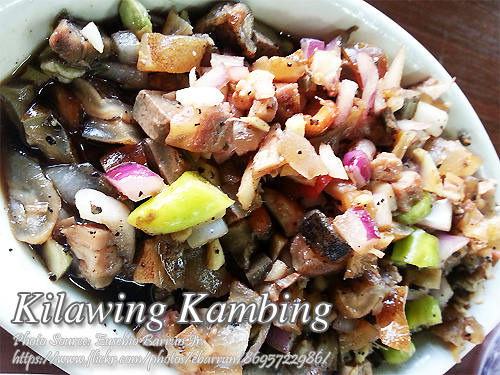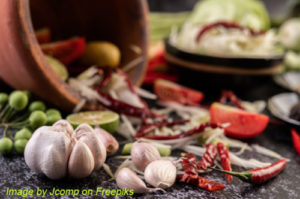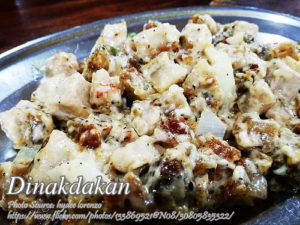Kilawing kambing is an Ilokano dish made from goat skin and goat meat cooked and marinated in vinegar and spices. Actually kinilaw is supposed to be raw meat or fish that is marinated in vinegar and lime, a ceviche to be exact but since goat skin and meat are tough, it has to be cooked first before mixing it with vinegar and spices.
There are also different method of cooking the goat meat and skin. If the goat is young, then it can be grilled without boiling it. But if it is more than 9 months old and above, the meat is already tough and you need to tenderize by boiling the goat meat. You can also grill the goat meat after boiling before making it into a kilawin.
A Taste of Ilokano Heritage
Kilawing kambing is an Ilokano dish that truly speaks of the unique flavorful taste and rich culinary traditions in the Philippines, especially from the Ilocos region. This goat skin and meat vinegar and spices marinade is a proof of the resourcefulness and creativity that channeled Ilokano cuisine into such a noteworthy dish. The term “kinilaw” generally pertains to the raw meat or fish marinated in vinegar and lime, similar to a ceviche. However, since goat meat and skin are tougher than fish or other meats often used in kinilaw, goat meat and skin have to be first cooked before marinating. This dish not only yields a fantastic culinary experience but also gives a glimpse into the rich cultural heritage of the Ilokano people.
Preparing the Goat Meat and Skin
Kilawin begins with burning the hairs off the goat skin. This is very essential because it leaves the skin well clean, ready for preparation in a kitchen. Upon getting all the hairs burnt, there should be boiling of water with laurel leaves then salt boiled with the goat meat and skin. This presents tenderization to the meat to become soft and enjoy more with chewing. If the goat is still young, below nine months of age, it can be grilled; otherwise, boiling is needed since goat meat is not that soft. Boiling for older goat is the primary process in order to make the meat tender enough. In itself, this cooking process shows how the traditional Ilokano cooking is able to be accommodative and practical.
Marinating with Vinegar and Spices
Boiled goat meat and skin are chopped into small pieces and set aside to cool. It’s the marinating process that makes this kilawin taste so distinct. In a large bowl, go mixed with onion and siling labuyo (or bird’s eye chili), is combined with vinegar. Those ingredients don’t only add heat but also balance the richness of the goat meat with a good sour acidic taste. This mixture is thrown together with the sliced goat meat and skin. The mixture is seasoned with salt and black pepper before being placed in a bowl to marinate. The bowl is covered either with cling wrap or a lid, and placed into the fridge for at least two hours. This provides sufficient time for the flavors to meld and seep deeply into the meat.
Kilawing Kambing Servings
The best way to serve the dish is chilled. The dish serves as a cooling dish for very warm climate conditions. Traditionally, it is dished up with a side of thinly sliced cucumber-thinly sliced bits that add a crisp and refreshing coolness to the spicy and sour goat meat. The dish is a testimonial not only to the ingenuity of Ilokano cooking but also to local ingredients and flavors. It is normally savored as main course in special occasions and gatherings, bringing people to come together to enjoy its unique taste.
Historical Background
The processing and consumption of goat meat in the Philippines date back hundreds of years with goat farming practices often found in most rural areas. Goat meat, or chevon, contains more flavor and nutrients with less fat content as compared to other meats. Goats are often raised in backyard farms in Ilokano culture, hence making a readily available and sustainable source of protein. Just like the preference of Filipinos towards locally available products and preservation, vinegar and spices reveal this influence on the Filipino traditions of cooking.
Food for Thought: The Role of Vinegar in Filipino Cuisine
In Filipino cooking, vinegar plays a very important role not only as a flavoring agent but also as a preservative. For long, food preservation was essential in the tropics of the Philippines. Vinegar is acidic, so bacteria cannot grow; thus, dishes like this may be safely preserved. Preservation using vinegar rests on a heritage from the Philippines, where vinegar was used to extend, in the centuries gone by, the shelf life of many foods. Besides producing it more flavorful, vinegar use also connects the food into a greater tradition of Filipino culinary practice, with an emphasis on food safety and durability.
Try Kilawing Kambling Wow
Today, the dish remains popular in Ilocos and everywhere else. It changes slightly from family recipes to regional preferences, but the core elements of tender goat meat and skin drenched in a vibrant mix of vinegar and spices remain the same. Whether you are enjoying it part of a festive meal or as a special treat, the dish offers a flavorful journey into the heart of Ilokano culinary heritage. As more people discover and take an appreciation for traditional Filipino dishes, one obvious shining example emerges in the delicious form of kilawing kambing, where traditional cooking methods come together with local ingredients to create something truly unique and memorable.
It is beyond being a dish; it is a celebration of Ilokano culture, a testament to the resourcefulness of Filipino cooking, and a flavorful journey that lets one connect with rich food heritage that must be seen in the Philippines.
How to make Kilawing Kambing
Ingredients
- 1/2 kilo goat meat with skin get from thigh, neck and shoulder
- water for boiling
- 2 pcs laurel leaves
- 2 pc red onion minced
- 1 1/2 Tbsp. ginger minced
- 3 pcs siling labuyo or siling haba chopped
- 1/2 cup coconut or palm vinegar
- salt and pepper to taste
Instructions
How to make kilawing kambing:
- Burn the hairs of the goatskin. In a pot, put water, goat meat and skin, laurel leaves and salt for about an hour or until tender.
- Remove from water and cool down. Slice the goat meat and skin into small pieces. Set aside.
- In a large bowl, combine onion, siling labuyo and vinegar. Mix well and toss in the goat skin and meat. Season with salt and pepper and toss until all the ingredients are well blended.
- Cover with cling wrap or cover with lid and refrigerate for 2 hours. Serve with a side dish of thinly sliced cucumber on the side.
Notes
Cooking Tips:
Tenderizing the Meat
Boil goat with laurel leaves and salt until it becomes as tender as you like it. If the meat comes from a young goat, you may opt to grill it since it will certainly get its more robust flavor. With adult goats, always boil first to achieve the right texture before doing any other step in this recipe.Balancing the Vinegar
Using quality vinegar will make all the difference to elevate the flavor of your goat recipe; it is basically one of the essentials. So adjust how much tang you want, add more if you prefer stronger, and less if you want milder.Spice it Up
To give it a spicy peppered flavor, you can add a dash of siling labuyo or bird's eye chili. Of course, you can adjust the chili peppers according to taste, start with a small amount and add more gradually if you prefer spicier. A flavor combination of various types of chili peppers can also provide a rich flavor.






Where can I buy goat skin to make Kilawin
Hi Yvonne, you need to buy goat meat with skin.